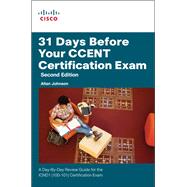31 Days Before Your CCENT Certification Exam Second Edition
A Day-By-Day Review Guide for the ICND1 (100-101) Certification Exam
31 Days Before Your CCENT Certification Exam offers you a personable and practical way to understand the certification process, commit to taking the 100-101 ICND1 certification exam, and finish your preparation using a variety of Primary and Supplemental study resources.
With a CCENT (Cisco Certified Entry Networking Technician) certification, a network professional demonstrates the skills required for entry-level network support positions—the starting point for many successful careers in networking. CCENT is the first step toward achieving CCNA certification.
Sign up for the ICND1 exam and use the book’s day-by-day guide and checklist to organize, prepare, and review. Each day in this guide breaks down an exam topic into a manageable bit of information to review using short summaries. A Study Resources section provides you with a quick reference for locating more in-depth treatment of a day’s topics within the Primary and Supplemental resources.
The features of the book empower you to fit exam preparation into a busy schedule:
--Visual calendar summarizing each day’s study topic
--Checklist providing advice for preparation activities leading up to the exam
--Description of the 100-101 ICND1 exam organization and sign-up process
--Strategies from the author to be mentally, organizationally, and physically prepared for exam day
--Conversational tone, which makes your study time more enjoyable
Primary Resources:
Cisco CCENT/CCNA ICND1 100-101 Official Cert Guide
ISBN: 9781587143854
Interconnecting Cisco Network Devices, Part 1 Foundation Learning Guide
ISBN: 9781587143762
Introduction to Networks Companion Guide
ISBN: 9781587133169
Introduction to Networks Lab Manual
ISBN: 9781587133121
Routing and Switching Essentials Companion Guide
ISBN: 9781587133183
Routing and Switching Essentials Lab Manual
ISBN: 9781587133206
Supplemental Resources:
CCENT Practice and Study Guide
ISBN: 9781587133459
Cisco CCENT ICND1 100-101 Flash Cards and Exam Practice Pack
ISBN: 9781587203992
CCNA Routing and Switching Portable Command Guide, 3e
ISBN: 9781587204302
Cisco CCENT ICND1 100-101 Network Simulator
ISBN: 9780789750433








